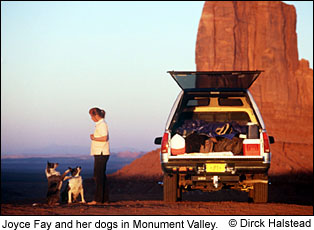|
Listening to the Inner Voices Joyce Fay, who contributed the feature story in this month's issue, had cultivated some wonderful clients. Among them, the famous glass maker Steuben, came to love her still life photos of their work. She photographed the crystal sculptures on a tabletop set in her Manhattan apartment, while Admiral Byrd, her green parakeet, happily critiqued the work from his perch on a light stand nearby. It was ideal--the overhead was low, and the pay was high. Year after year, she turned out beautiful images used in advertising and catalogs for Steuben, as well as the Metropolitan Museum of Art. Yet, something was missing, something was calling her. As a child, she recalled crossing the Nevada desert with her great aunt and uncle in the Santa Fe Superchief. Watching the sunset from the train's vistadome, she fell in love with the West. In 1981, while on vacation in Wyoming, Joyce decided to drive south through Utah, then on to Arizona and New Mexico. It was this experience that convinced her to follow her heart--to ride on horseback across the vast spaces of Navajo land, to live in this magical part of the county.
Harper Collins, a few years ago, published her first book, The Adventures of Bro and Tracy, and note cards of her photographs are sought by animal lovers everywhere. Joyce is an example of how photographers can find an entirely new direction, within their careers, by following their dreams. David Douglas Duncan was known as a swashbuckling photojournalist, whose work for Life magazine took him to war zones and news fronts all over the globe. His book, Yankee Nomad, published in the early '60s, celebrated his macho world. But his life and fortunes were to change. After the battle of Khe Sanh, in 1968, he published, with his own money, the book I Protest, which registered his anger over the waste of U.S. Marines' lives. He left photojournalism after this, and took his passion for art and life in a new direction: covering the world of Pablo Picasso. He fell in love with the sunflowers that filled the fields of southern France, and decided this was where he want to live. Books and shows of his many flower pictures were to follow. The photographing of nature also preoccupies Don McCullin, probably the most famous war photographer of our generation. After escaping death many times, by the thinnest of margins, Don now photographs the country landscapes near his home in northern England. The melancholy and pain so much within him and so searingly apparent in his war photos, have now been tempered and transferred to his haunting black and white landscapes. The late Alfred Eisenstaedt balanced his travels as the most famous of Life photographers, by spending his summers in a small cabin on Martha's Vineyard, off the coast of Massachusetts. Here, on this island surrounded by the sea, he found the subjects he most loved. His photographs of the Vineyard are published in many books, and are still shown in exhibitions all over the world. Photographers, like writers and artists, often get better at what they do as they get older. Sensitivity, and the accumulation of experience, enrich their work. The eye is a god-given gift, but once the photographer listens to his or her own inner voices, then the magic of greatness can happen. Dirck Halstead |
 She
listened to those inner voices, and a year later packed her cameras in
her car, bid good-bye to her New York City home, and headed off on her
journey west. Arriving on the Navajo reservation in Arizona, she settled
into a small trailer. Soon after, she met and married Ed Camron, a power
lineman. Joyce bought two horses, and later, two Australian herder dogs
were added to the family. She started to work with her animals, photographing
them in the beauty of places like Monument Valley.
She
listened to those inner voices, and a year later packed her cameras in
her car, bid good-bye to her New York City home, and headed off on her
journey west. Arriving on the Navajo reservation in Arizona, she settled
into a small trailer. Soon after, she met and married Ed Camron, a power
lineman. Joyce bought two horses, and later, two Australian herder dogs
were added to the family. She started to work with her animals, photographing
them in the beauty of places like Monument Valley.